
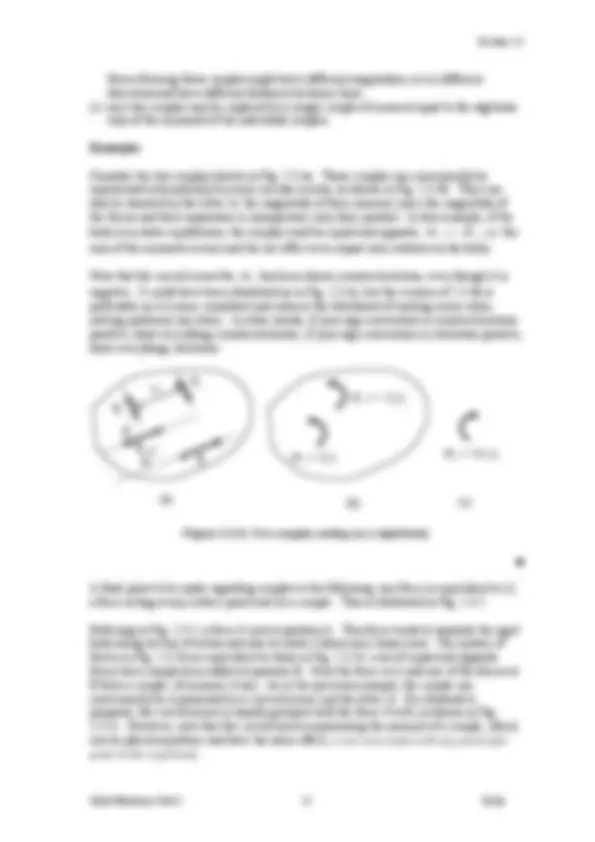
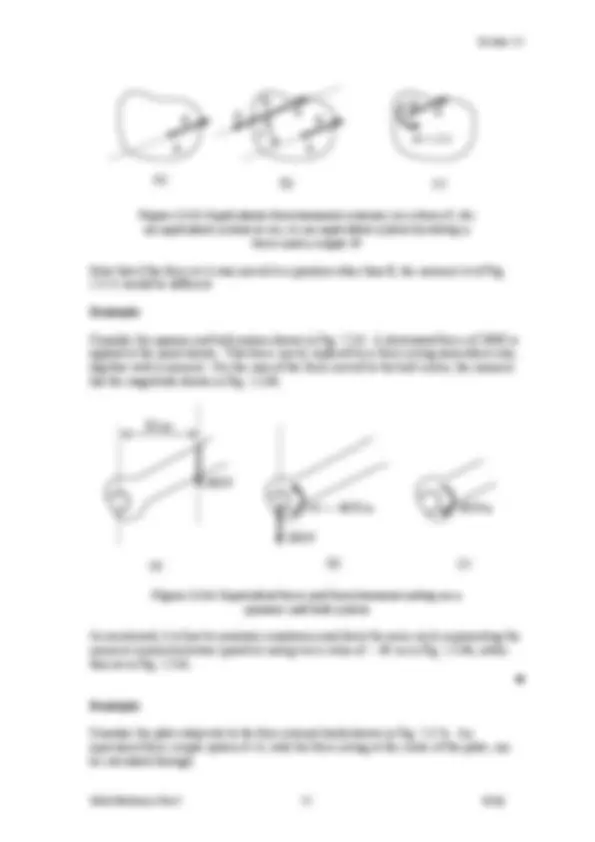
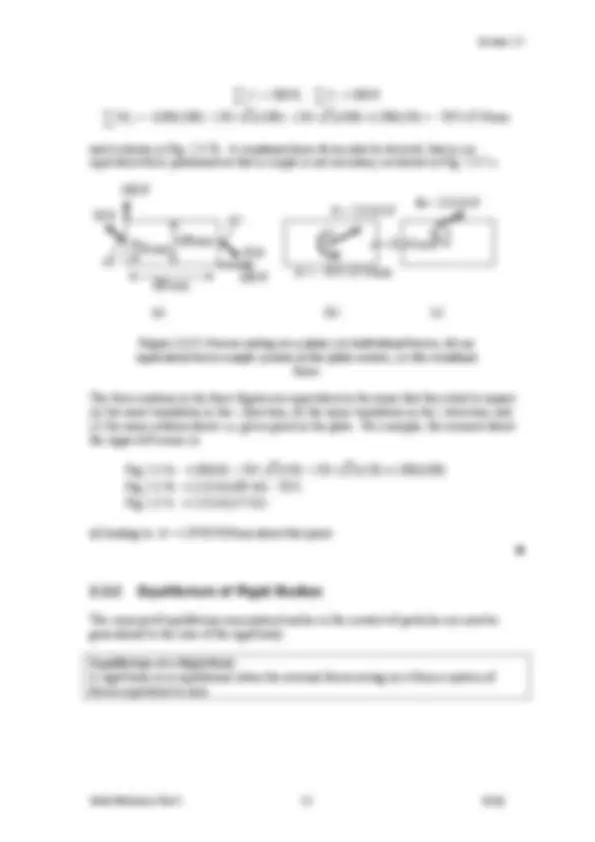
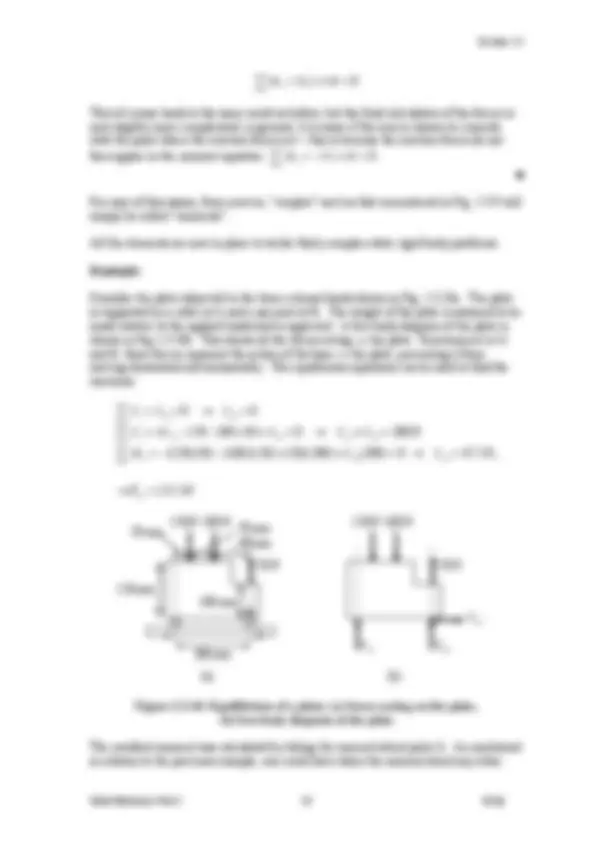
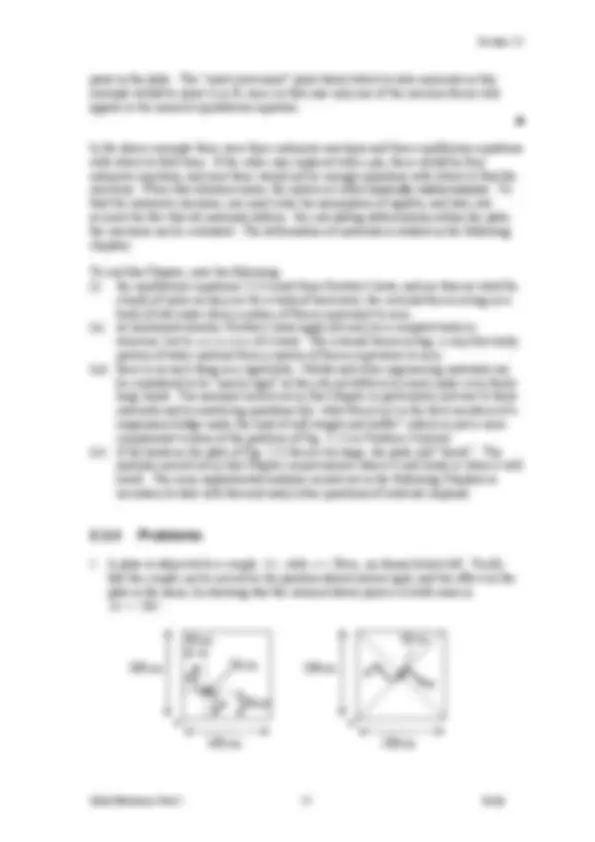
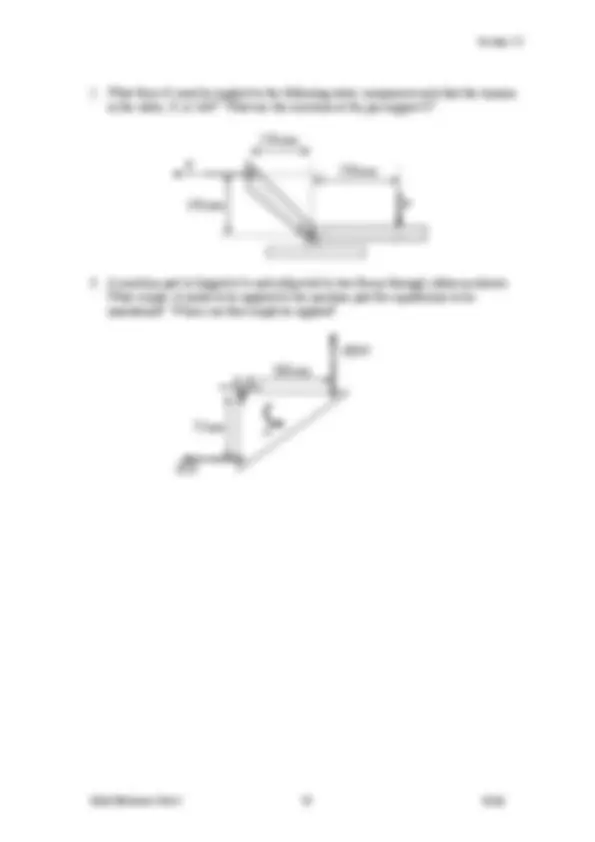


Study with the several resources on Docsity

Earn points by helping other students or get them with a premium plan


Prepare for your exams
Study with the several resources on Docsity

Earn points to download
Earn points by helping other students or get them with a premium plan
Community
Ask the community for help and clear up your study doubts
Discover the best universities in your country according to Docsity users
Free resources
Download our free guides on studying techniques, anxiety management strategies, and thesis advice from Docsity tutors
A new aspect of mechanics to be considered here is that a rigid body under the action of a force has a tendency to rotate about some axis.
Typology: Exercises
1 / 10

This page cannot be seen from the preview
Don't miss anything!







A material body can be considered to consist of a very large number of particles. A rigid body is one which does not deform, in other words the distance between the individual particles making up the rigid body remains unchanged under the action of external forces.
A new aspect of mechanics to be considered here is that a rigid body under the action of a force has a tendency to rotate about some axis. Thus, in order that a body be at rest, one not only needs to ensure that the resultant force is zero, but one must now also ensure that the forces acting on a body do not tend to make it rotate. This issue is addressed in what follows.
When you swing a door on its hinges, it will move more easily if (i) you push hard, i.e. if the force is large, and (ii) if you push furthest from the hinges, near the edge of the door. It makes sense therefore to measure the rotational effect of a force on an object as follows:
The tendency of a force to make a rigid body rotate is measured by the moment of that force about an axis. The moment of a force F about an axis through a point o is defined as the product of the magnitude of F times the perpendicular distance d from the line of action of F and the axis o. This is illustrated in Fig. 2.3.1.
Figure 2.3.1: The moment of a force F about an axis o (the axis goes “into” the page)
The moment M (^) oof a force F can be written as
M (^) 0 Fd (2.3.1)
Not only must the axis be specified (by the subscript o ) when evaluating a moment, but the sense of that moment must be given; the convention that a tendency to rotate counterclockwise is taken to be a positive moment will be used here. Thus the moment in Fig. 2.3.1 is positive. The units of moment are the Newton metre (Nm).
Note that when the line of action of a force goes through the axis, the moment is zero.
d (^)
Rigid body
o
F (^) line of action of force
axis
point of application of force
It should be emphasized that there is not actually a physical axis, such as a rod, at the point o of Fig. 2.3.1; in this discussion, it is imagined that an axis is there.
Two forces of equal magnitude and acting along the same line of action have not only the same components Fx , Fy , but have equal moments about any axis. They are called
equivalent forces since they have the same effect on a rigid body. This is illustrated in Fig. 2.3.2.
Figure 2.3.2: Two equivalent forces
Consider next the case of two forces of equal magnitude, parallel lines of action separated by distance d , and opposite sense. Any two such forces are said to form a couple. The only motion that a couple can impart is a rotation; unlike the forces of Fig. 2.3.2, the couple has no tendency to translate a rigid body. The moment of the couple of Fig. 2.3. about o is
M (^) o Fd 2 Fd 1 Fd (2.3.2)
Figure 2.3.3: A couple
As with the moment, the sign convention which will be followed in what follows is that a couple is positive when it acts in a counterclockwise sense, as in Fig. 2.3.3.
It is straight forward to show the following three important properties of couples: (a) the moment of Fig. 2.3.3 is also Fd about any axis in the rigid body, and so can be represented by M , without the subscript. In other words, this moment of the couple is independent of the choice of axis. {see ▲Problem 1} (b) any two different couples having the same moment M are equivalent, in the sense that they tend to rotate the body in precisely the same way; it does not matter that the
o
F d
d 1
d 2
d
Rigid body
o F 1 (^) line of action of force
F 2
Figure 2.3.5: Equivalents force/moment systems; (a) a force F, (b) an equivalent system to (a), (c) an equivalent system involving a force and a couple M
Note that if the force at A was moved to a position other than B, the moment M of Fig. 2.3.5c would be different.
Example
Consider the spanner and bolt system shown in Fig. 2.3.6. A downward force of 200N is applied at the point shown. This force can be replaced by a force acting somewhere else, together with a moment. For the case of the force moved to the bolt-centre, the moment has the magnitude shown in Fig. 2.3.6b.
Figure 2.3.6: Equivalent force and force/moment acting on a spanner and bolt system
As mentioned, it is best to maintain consistency and draw the semi-circle representing the moment counterclockwise (positive) and given a value of 40 as in Fig. 2.3.6b; rather than as in Fig. 2.3.6c. ■
Example
Consider the plate subjected to the four external loads shown in Fig. 2.3.7a. An equivalent force-couple system F - M , with the force acting at the centre of the plate, can be calculated through
d
F F
M Fd
(a) (^) (b) (c)
(a) (b)
20 cm
M 40 Nm
(c)
40 Nm
o
M (100)(100) (50 / 2)(100) (50 / 2)(100) (200)(50) 7071.07 Nmm
F x Fy
and is shown in Fig. 2.3.7b. A resultant force R can also be derived, that is, an equivalent force positioned so that a couple is not necessary, as shown in Fig. 2.3.7.c.
Figure 2.3.7: Forces acting on a plate; (a) individual forces, (b) an equivalent force-couple system at the plate-centre, (c) the resultant force
The force systems in the three figures are equivalent in the sense that they tend to impart (a) the same translation in the x direction, (b) the same translation in the y direction, and (c) the same rotation about any given point in the plate. For example, the moment about the upper left corner is
Fig 2.3.7a: (100)(0) (50 / 2)(50) (50 / 2)(150) (200)(100) Fig 2.3.7b: ( 223. 61 )( 89. 44 ) 7071 Fig 2.3.7c: ( 223. 61 )( 57. 82 )
all leading to M 12928. 93 Nmmabout that point.
■
The concept of equilibrium encountered earlier in the context of particles can now be generalized to the case of the rigid body:
Equilibrium of a Rigid Body A rigid body is in equilibrium when the external forces acting on it form a system of forces equivalent to zero
M 7071. 07 Nmm
(a) (b) (c)
100 mm
200 mm
50 mm 45 o
45 o
d 31 .62 mm
o o
through the hinge pin to the component, which can have both normal ( R (^) y ) and tangential
( R (^) x ) components.
Finally, in Fig. 2.3.8c is shown a fixed (clamped) joint. Here the component is welded or glued and cannot move at the base. It is said to be cantilevered. The support in this case reacts with normal and tangential forces, but also with a couple of moment M , which resists any bending/turning at the base.
Example
For example, consider such a component loaded with a force F a distance L from the base, as shown in Fig. 2.3.9a. A free-body diagram of the component is shown in Fig. 2.3.9b. The known force F acts on the body and so do two unknown forces R (^) x , R (^) y , and
a couple of moment M. The unknown forces and moment will be called reactions henceforth. If the component is static, the equilibrium equations 2.3.3 apply; one has, taking moments about the base of the component,
and so
R (^) x F , Ry 0 , M FL
The moment is positive and so acts in the direction shown in the Figure.
Figure 2.3.9: A loaded cantilevered component; (a) loaded component, (b) free body diagram of the component
The reaction moment of Fig. 2.3.9b can be experienced as follows: take a ruler and hold it firmly at one end, upright in your right hand. Simulate the applied force now by pushing against the ruler with a finger of your left hand. You will feel that, to maintain the ruler “vertical” at the base, you need to apply a twist with your right hand, in the direction of the moment shown in Fig. 2.3.9b.
Note that, when solving this problem, moments were taken about the base. As mentioned already, one can take the moment about any point in the column. For example, taking the moment about the point where the force F is applied, one has
(b)
R x R y
M (a)
o
This of course leads to the same result as before, but the final calculation of the forces is now slightly more complicated; in general, it is easier if the axis is chosen to coincide with the point where the reaction forces act – this is because the reaction forces do not
For ease of discussion, from now on, “couples” such as that encountered in Fig. 2.3.9 will simply be called “moments”.
All the elements are now in place to tackle fairly complex static rigid body problems.
Example
Consider the plate subjected to the three external loads shown in Fig. 2.3.10a. The plate is supported by a roller at A and a pin-joint at B. The weight of the plate is assumed to be small relative to the applied loads and is neglected. A free body diagram of the plate is shown in Fig 2.3.10b. This shows all the forces acting on the plate. Reactions act at A and B: these forces represent the action of the base on the plate, preventing it from moving downward and horizontally. The equilibrium equations can be used to find the reactions:
A
x xB xB y yA yB yA yB yB yB
yA
Figure 2.3.10: Equilibrium of a plate; (a) forces acting on the plate, (b) free-body diagram of the plate
The resultant moment was calculated by taking the moment about point A. As mentioned in relation to the previous example, one could have taken the moment about any other
(a) (b)
150 mm
200 mm
100 mm
50 mm 80 mm
70 mm 150 N^100 N
F yA FyB
FxB A B
150 mm
150 mm
250 mm
100 mm
75 mm M
A